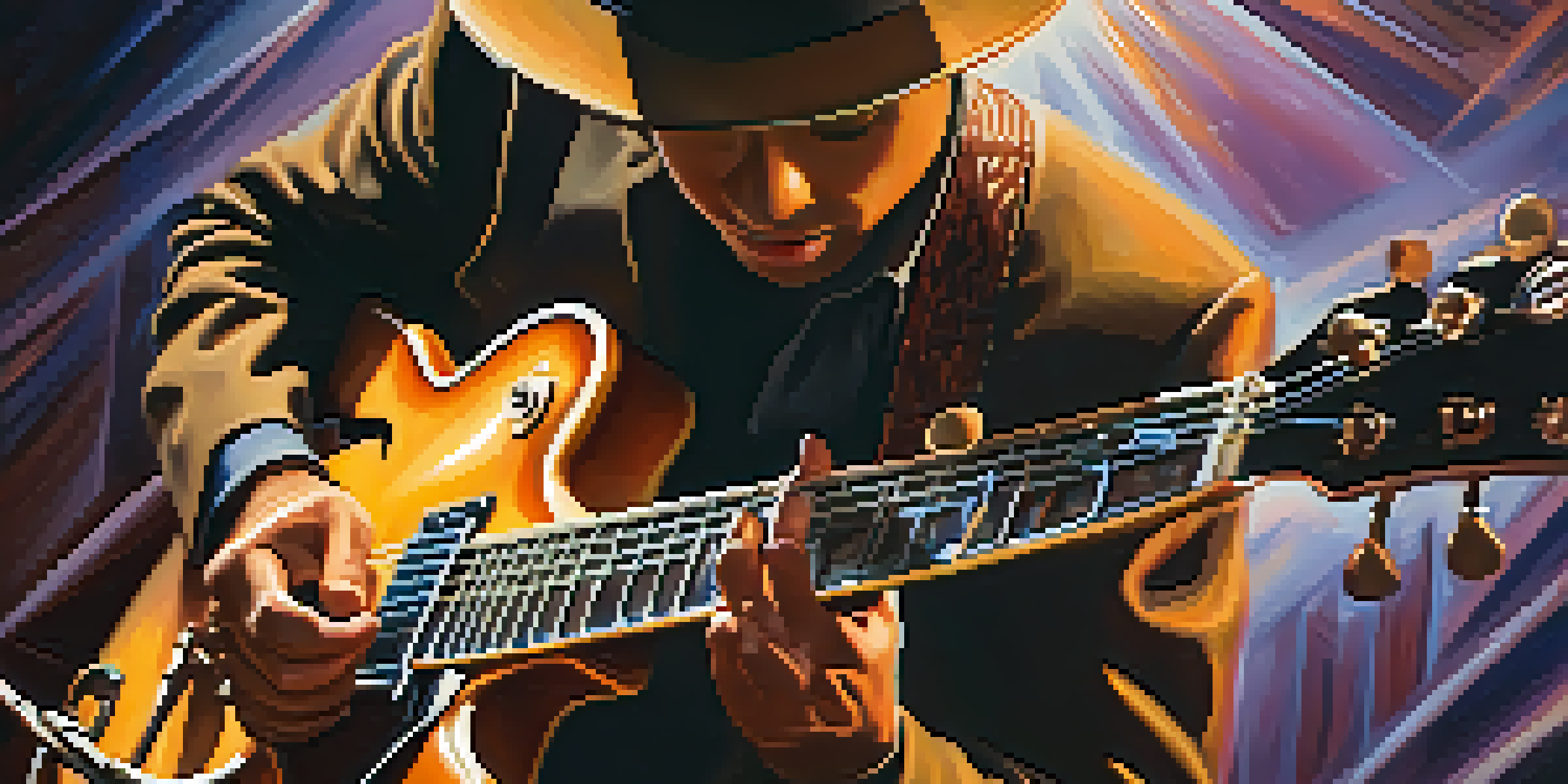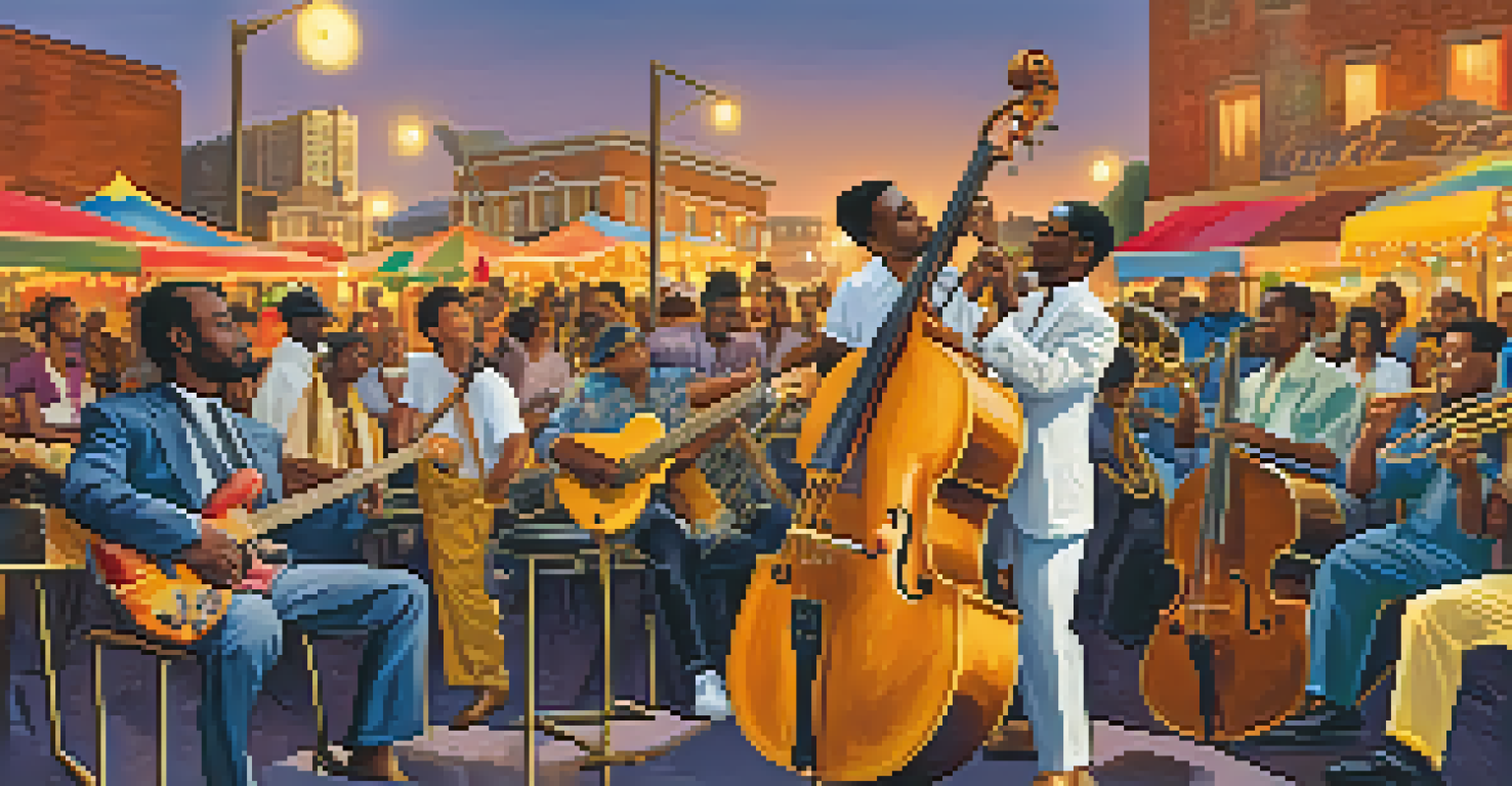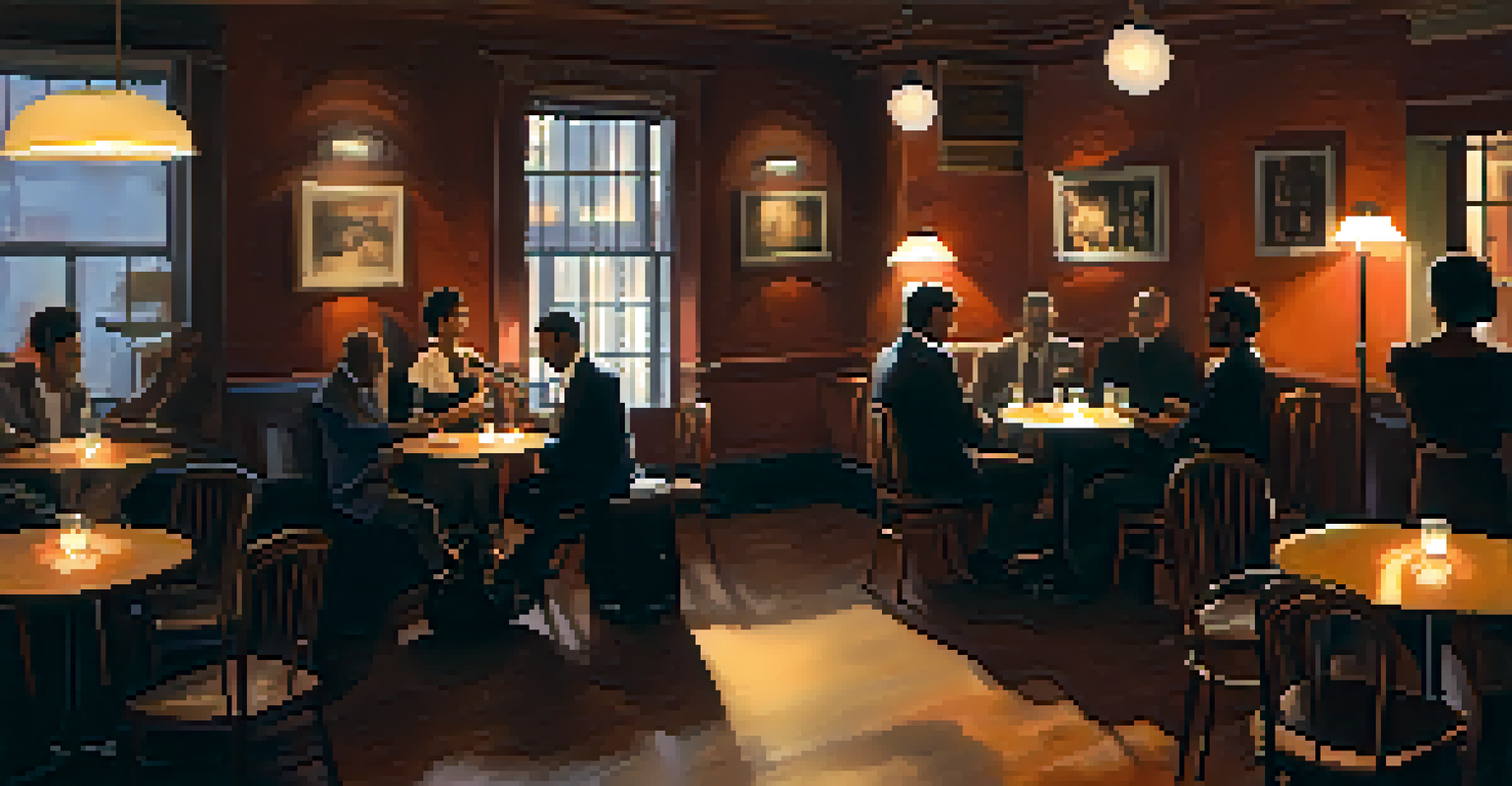Famous Jazz Guitar Solos: A Study of Improvisation

The Essence of Jazz Guitar and Improvisation
Jazz guitar is more than just music; it's a vibrant conversation between musicians. At its core, improvisation allows guitarists to express their emotions and creativity spontaneously. Each note played is a reflection of the moment, making every performance unique and fresh.
The beauty of jazz is that it’s a spontaneous conversation. It’s not about the notes; it’s about the feeling behind them.
For instance, when a guitarist steps into a solo, they often draw from both their technical skills and their feelings at that moment. This blend of spontaneity and technique is what makes jazz so captivating. It's not merely about following a set structure; it's about weaving a story through sound.
Improvisation in jazz guitar invites listeners to connect with the music on a personal level. The unpredictability of where a solo might go keeps the audience engaged, as they never know what to expect next. This is the magic of jazz, where each solo is a journey waiting to unfold.
Charlie Christian: The Pioneer of Jazz Guitar Solos
One of the first guitarists to truly shine in jazz improvisation was Charlie Christian. His groundbreaking solos in the late 1930s paved the way for future generations of jazz guitarists. Christian's fluid style and use of the electric guitar transformed how the instrument was perceived in jazz music.

His famous solo on 'Swing to Bop' showcases his ability to blend melody and rhythm seamlessly, creating a captivating narrative. Listeners can almost hear the joy of the swing era in his playing, making it a timeless piece. This solo not only highlighted his technical prowess but also his ability to improvise melodically.
Improvisation Defines Jazz Guitar
Jazz guitar is characterized by improvisation, allowing musicians to express their emotions and creativity spontaneously.
Charlie Christian's influence is still felt today, as many guitarists cite him as an inspiration. His contributions to jazz guitar improvisation set the stage for the rich tapestry of styles that would follow, making him a true legend in music history.
Wes Montgomery: The Master of Octaves
Wes Montgomery is often celebrated for his unique approach to improvisation, particularly his use of octaves. By playing two notes simultaneously, he created a fuller, richer sound that captivated audiences. His technique added depth to his solos, making them instantly recognizable.
Improvisation is the ultimate expression of creativity, where musicians tell their stories in real-time.
A standout example of his mastery is the solo in 'West Coast Blues.' Here, Montgomery combines his octave technique with fluid runs and rhythmic complexity, showcasing his ability to create both melody and harmony simultaneously. His improvisation feels like a conversation, with each note responding to the last.
Montgomery's style emphasizes the importance of phrasing in jazz guitar. He often used subtle pauses and variations in dynamics, allowing his solos to breathe. This attention to detail makes his improvisations not just impressive but deeply emotive, resonating with listeners long after the music stops.
Pat Metheny: The Fusion Innovator
Pat Metheny brought a fresh perspective to jazz guitar with his fusion of styles, incorporating elements from rock, folk, and world music. His improvisations often reflect a blend of technical mastery and emotional depth, creating a unique sound that's distinctly his own. Metheny's approach allows him to connect with diverse audiences.
In the piece 'Bright Size Life,' Metheny's guitar work showcases his ability to improvise over complex chord changes seamlessly. His melodic lines are often lyrical and fluid, drawing listeners into a captivating musical journey. This piece exemplifies his innovative spirit and willingness to push the boundaries of jazz.
Influential Jazz Guitarists
Pioneers like Charlie Christian and innovators like Pat Metheny have shaped jazz guitar through their unique styles and contributions.
Metheny's impact on jazz guitar cannot be understated. He has inspired countless musicians to explore improvisation beyond traditional jazz, encouraging them to incorporate their own influences. This evolution of jazz guitar continues to resonate, highlighting Metheny's role as a trailblazer in the genre.
John Scofield: The Blend of Jazz and Blues
John Scofield is known for his ability to blend jazz with blues elements, creating a distinctive sound that's both soulful and sophisticated. His improvisational style reflects a deep understanding of both genres, allowing him to traverse musical landscapes effortlessly. Scofield's solos often feature a mix of complex jazz harmony and bluesy phrasing.
A perfect example of his skill is found in 'A Go Go,' where he beautifully balances intricate melodic lines with a laid-back groove. His improvisation feels conversational, inviting listeners to join in on the musical dialogue. This seamless integration of styles is what sets Scofield apart in the jazz world.
Scofield's contributions have inspired many guitarists to explore the connections between jazz and blues. His work serves as a reminder that improvisation is not just about technical skill but also about emotional expression and storytelling through music. This blend of genres showcases the versatility of jazz guitar.
The Legacy of Jazz Guitar Solos
The legacy of jazz guitar solos is rich and varied, with countless musicians contributing their voices to this ever-evolving genre. Each guitarist brings their unique style and perspective, enriching the tapestry of jazz history. This legacy influences not only jazz musicians but also artists across many genres.
As jazz continues to evolve, the principles of improvisation remain at its core. New generations of guitarists are exploring traditional techniques while also incorporating modern influences, creating a dynamic fusion of sounds. This evolution ensures that jazz guitar stays relevant and vibrant in today's music scene.
Legacy of Jazz Guitar Solos
The legacy of jazz guitar is a rich tapestry of diverse influences, showcasing the genre's evolution and emotional storytelling.
The stories told through these solos resonate with listeners, inviting them to experience the emotions and narratives embedded in each note. The legacy of jazz guitar is not just about the past; it's a living, breathing art form that continues to inspire and connect people through the universal language of music.
Lessons from Famous Jazz Guitar Solos
Studying famous jazz guitar solos offers valuable lessons for aspiring musicians. One key takeaway is the importance of listening—great improvisers are often great listeners. They pay attention to the music around them, allowing them to respond and interact dynamically during performances.
Another lesson is the significance of practice and preparation. While improvisation may seem spontaneous, it relies on a solid foundation of technique and theoretical knowledge. By mastering scales, chords, and rhythms, musicians can free themselves to express their creativity more fully when it's time to improvise.

Finally, the essence of jazz improvisation lies in vulnerability and authenticity. Great solos are often born from genuine emotion and personal experiences. Aspiring guitarists are encouraged to embrace their unique voices and stories, allowing them to contribute their own narratives to the rich history of jazz.
Conclusion: The Continuing Journey of Jazz Guitar
The journey of jazz guitar is a continuous exploration of sound, emotion, and creativity. From pioneers like Charlie Christian to modern innovators like Pat Metheny, each guitarist adds to this vibrant tradition. The art of improvisation remains a cornerstone of jazz, inviting musicians and listeners alike to engage with the music in a deeply personal way.
As new styles and influences emerge, the essence of jazz guitar will continue to evolve, reflecting the world around us. Each solo is a testament to the artist's journey and a reminder of the power of music to connect and inspire. The legacy of jazz guitar is not just in the notes played but in the stories told through them.
Ultimately, jazz guitar invites us all to listen closely and embrace the beauty of improvisation. It encourages us to find our own voices and share our stories through music. As we celebrate the famous solos of the past, we also look forward to the new voices that will shape the future of jazz guitar.